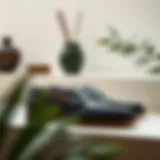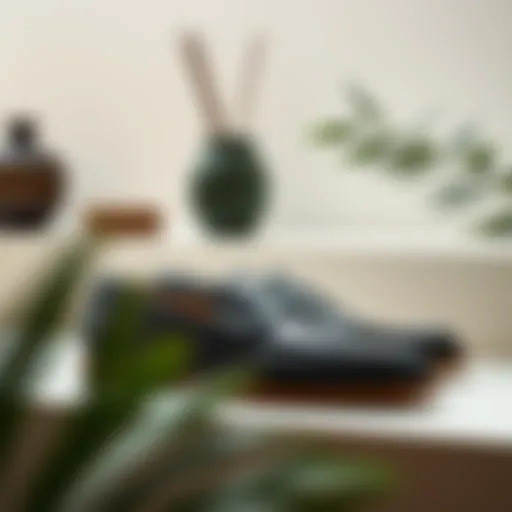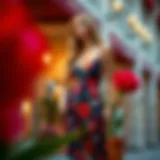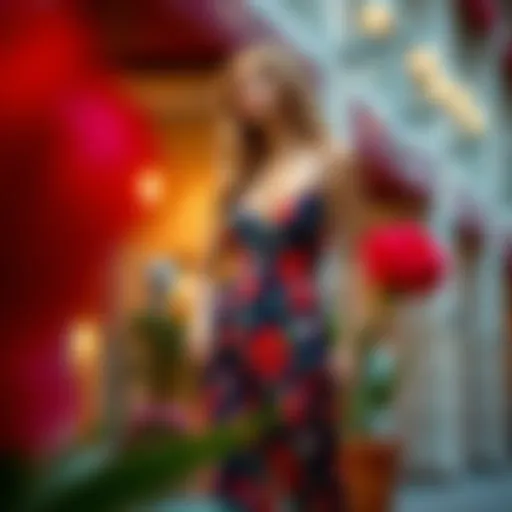Exploring the Essence of Opaque Chiffon Hijabs
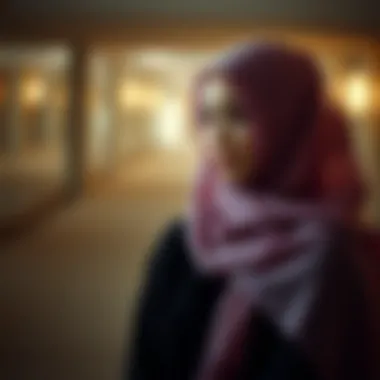

Intro
In today's world of fashion, the hijab has transformed from a mere accessory to a statement of style and cultural identity. One of the key players in this evolving landscape is the opaque chiffon hijab, a fabric that combines elegance and practicality. As more people embrace its unique features, understanding this garment becomes essential for stylists, designers, and even everyday wearers.
Opaque chiffon is not just about aesthetic appeal; it's woven with stories and traditions that span generations. This article will take you through the characteristics of the fabric itself, its cultural significance, and practical tips on styling and maintenance. With sustainability and market trends in mind, we'll navigate through a comprehensive view of opaque chiffon hijabs that caters to the tastes of both enthusiasts and professionals.
Let's delve deeper into the fashion trends surrounding opaque chiffon hijabs, examining what's currently hot and iconic styles that have made a notable comeback.
Fashion Trends
Latest Seasonal Trends
The world of fashion is in a constant state of flux, and hijab styles are no different. In the current season, opaque chiffon hijabs are taking center stage with bold colors and intricate patterns that evoke a sense of luxury. Colors like deep teal, rich burgundy, and soft pastels are dominating the collections. Designers blend traditional motifs with contemporary color palettes to create pieces that resonate well with a modern audience.
Some of the trends that have emerged include:
- Layering: Wearing multiple hijabs in contrasting colors for a dynamic look.
- Textured Fabrics: Incorporating stripes or floral designs for visual interest.
- Versatility: Choosing hijabs that can easily transition from daytime casual to evening glam.
Iconic Styles Revived
Drawing inspiration from past decades often brings flair and character back to contemporary wardrobes. Recently, several iconic styles have resurged, making a strong case for opaque chiffon. The classic Amal Clooney-inspired wrap, for example, isn't just about function; it encapsulates sophistication and modern elegance. This style is characterized by its sweeping drape, framing the face beautifully while allowing movement.
Moreover, the retro '90s turban style is gaining traction, with many opting for this head-turning look. The combination of the turban style with soft chiffon offers an updated twist that is both striking and elegant. As a stylist, understanding these trends can guide your approach to curating an engaging collection of hijabs.
"Fashion is about more than just what you wear—it's a language that communicates identity, culture, and personality."
In summary, understanding current trends and iconic styles reviving offers a window into the evolving world of opaque chiffon hijabs. The melding of tradition with modern flair not only captures attention but enriches the narrative of fashion within diverse cultures. For those invested in the world of hijab fashion, being abreast of these trends is invaluable. Next, let’s look at some practical style tips for making the most of opaque chiffon hijabs.
Defining Opaque Chiffon
Opaque chiffon is a fabric that possesses a certain level of mystique while remaining practical, making it a popular choice in the world of hijabs. Understanding this material is crucial for both the fashion-conscious and professionals within the industry. Opaque chiffon brings together style and functionality. By diving into its material composition and characteristic features, we can appreciate its significance in the fashion realm, particularly in hijab styling.
Material Composition
At its core, opaque chiffon is primarily made from synthetic fibers, often polyester or nylon. Unlike its more sheer counterparts, opaque chiffon includes a higher denier count, lending it its thicker texture. This specific composition allows for a heavier drape, providing a modest and fashionable covering suitable for various occasions.
The fabric's composition does not only influence its look but its durability and ease of maintenance as well. For instance, a thicker yarn doesn't just hold dye better; it also withstands typical wear and tear, making it favorable for everyday use. The blend used in opaque chiffon can also sometimes include natural fibers like silk, but the synthetic base remains prominent, giving the hijab its desired opaque characteristic.
Also notable is the breathability of this fabric. Many who wear opaque chiffon hijabs appreciate how well the fabric can regulate temperature. Even in warmer conditions, wearing this material is often comfortable, straddling the line between being stylish and functional.
Characteristics of Chiffon
Chiffon itself, in general, is known for its lightness, transparency, and slightly crinkly texture. However, when we talk specifically about opaque chiffon, we touch upon some unique characteristics:
- Drapability: The way this material falls is crucial in styling. The weight of opaque chiffon allows it to drape gracefully, contributing to elegant silhouette when worn as a hijab.
- Modesty: Unlike sheer chiffon that may reveal more than intended, opaque chiffon offers a level of modesty that aligns with the wearer's preferences and cultural considerations.
- Versatility: Opaque chiffon can be styled in various ways, from simple wraps to more elaborate configurations. This adaptability keeps it relevant in everyday fashion.
- Color & Print Retention: The depth of color is richer compared to sheer fabrics. This means that the vibrancy of the patterns and hues stays true and does not fade easily in the wash.
In summary, defining opaque chiffon involves examining its structure and functions. This material serves as an embodiment of style and practicality, allowing hijab wearers to express their identity while adhering to cultural norms. By understanding these nuances, stylists, designers, and marketers can make informed decisions that resonate with today’s discerning consumers.
"Selecting the right fabric is not just about the look—it's about the sheer experience of wearing it."
For more insights about fabric types and their significance in fashion, you can explore resources on Wikipedia or conduct academic research through Britannica.
Ultimately, a deeper understanding of opaque chiffon might just pave the way for innovative use in hijab fashion, merging tradition with contemporary aesthetics.
The Cultural Significance of Hijabs
The cultural significance of hijabs cannot be understated. Hijabs serve as more than mere fashion items; they embody identity, beliefs, and heritage for many women around the world. The practice of wearing hijabs carries deep roots, linking back to various historical, religious, and cultural influences. This article aims to elucidate these intertwining aspects, emphasizing particularly on opaque chiffon hijabs, which have gained popularity due to their versatility and elegance.
Historical Context
Historically, the hijab has been a symbol of modesty and morality. The concept traces back centuries, with its presence noted in ancient civilizations; Egyptian women adorned themselves with veils not merely for modesty but as a sign of social status. The Quran and other religious texts also refer to guidelines regarding modest attire, which later influenced how the hijab was interpreted across different cultures.
The 7th century saw the formalization of hijabs among Muslim women as an expression of faith. Wearing a hijab served as a form of communal identity, distinguishing members of distinct cultures and religious sects. The historical underpinnings provide a fascinating narrative that reveals the evolution of hijab fashion over time. Today, a constant balancing act exists; while some insist on traditional interpretations, others integrate contemporary fashion influences, creating a dynamic dialogue between history and modern-day expressions.
Modern Interpretations
In today’s world, the hijab retains its cultural significance but has been reinterpreted in various ways. Modern hijab fashion has become a movement in itself—accessible and adaptable, allowing for individual expression. Women sport hijabs made of multiple fabrics including silk, cotton, and, most importantly, opaque chiffon—a choice that strikes the ideal balance between modesty and style.
Yellow floral print hijabs, for instance, cater to the contemporary woman who wishes to showcase her personality while adhering to cultural norms. With countless styles—from pins and wraps to more intricate turban styles—each choice can convey a different story, revealing how personal identity is expressed through attire. Fashion designers have also dived into this arena, creating collections that merge traditional elements with modern aesthetics, demonstrating how cultural attire can transcend generational divides.
Furthermore, the conversations surrounding hijabs have grown richer, especially regarding their implications in relation to feminism and empowerment. Many women wear the hijab as a testament to their identity, reclaiming it from stereotypes and showcasing their strength and independence. In social settings, and even within the realm of fashion networks, hijabs have become platforms for dialogue, fostering an atmosphere of understanding and acceptance.
"A hijab is not just a piece of cloth. It represents a layer of resilience and assertion of one’s beliefs."
In summary, the cultural significance of hijabs is intricately woven into the fabric of society through historical narratives and modern interpretations. Understanding these dimensions is crucial, especially when exploring styles like opaque chiffon that balance aesthetics with cultural roots.
Opaque Chiffon Versus Other Fabrics
When delving into the world of hijab fashion, understanding the nuances between fabrics is critical. Opaque chiffon stands out not just for its appearance, but for its unique array of qualities that distinguish it from other materials commonly used in hijabs, such as cotton, silk, or polyester. Let’s examine why choosing opaque chiffon can be a game-changer and what to consider when comparing it with its counterparts.
Comparative Analysis of Drapery
Drapery is a crucial element that affects not only how a hijab looks but also how it feels and functions in everyday use. Opaque chiffon is characterized by its soft, flowing texture that drapes beautifully around the silhouette. When worn, the softness allows for graceful movement, making the wearer feel more at ease while maintaining a chic appearance.
In comparison, cotton hijabs, while breathable and easy to handle, can sometimes lack the fluidity that chiffon offers. Cotton tends to be more rigid, and though it's comfortable, it may not create the same level of elegance. On the other hand, silk hijabs are luxurious and can provide a similar draping effect. However, silk is often delicate and may require more careful handling and maintenance, which could deter some individuals from choosing it for everyday use.
Additionally, polyester hijabs are often less breathable than chiffon and can feel sticky or heavy, especially in warmer climates. Opaque chiffon provides a breathable option without sacrificing style, making it perfect for various weather conditions.
"The right draping can elevate even the most basic outfit, drawing attention to the elegance of the wearer without overwhelming their style."
Durability and Care Differences
Durability is another pivotal aspect when choosing fabric, particularly for those who frequently adjust their attire throughout the day. Opaque chiffon strikes a desirable balance between delicacy and sturdiness. It is resilient enough to withstand daily wear without losing its appeal, making it an excellent choice for both casual outings and formal events.
In contrast, cotton hijabs, while generally durable, can fade over time or develop wear if not cared for properly. Silk, although beautiful, tends to snag or fray easily and calls for more cautious washing methods. Polyester fabrics offer great durability, but often at the cost of wearers' comfort, as synthetic materials can trap heat and moisture.
Care for opaque chiffon is relatively straightforward. Here are some tips:
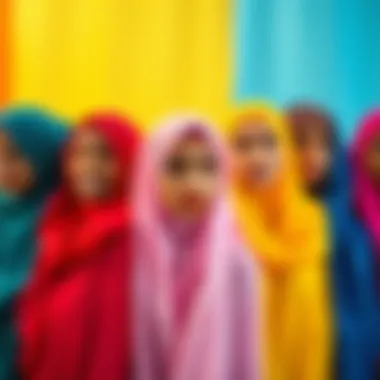

- Washing: Hand wash in cold water using mild detergent.
- Drying: Air dry preferably by laying flat, avoiding prolonged exposure to direct sunlight to prevent fading.
- Ironing: If necessary, use a low heat setting; avoid direct contact with an iron to maintain the delicate appearance of the fabric.
When comparing care routines, opaque chiffon often requires less effort than silk, which necessitates careful steaming or dry-cleaning.
Therefore, for anyone seeking a practical yet elegant option that balances style and ease of maintenance, opaque chiffon proves to be a solid choice within the landscape of fabric options for hijabs.
Styling Opaque Chiffon Hijabs
Styling opaque chiffon hijabs is more than just a fashion statement; it's a nuanced expression of personal identity and cultural heritage. In today’s diverse world, there’s a growing appreciation for the art of hijab styling, especially when it comes to using materials like chiffon that lend themselves to a myriad of looks. This section will explore key elements such as layering techniques, color coordination, and styles suited for various occasions - all pivotal in elevating the opaque chiffon hijab’s appeal.
Layering Techniques
Layering can significantly enhance the aesthetic and comfort of opaque chiffon hijabs. Unlike heavier materials, chiffon has a lightweight quality that allows for multiple layers without feeling bulky. Here are some notable ways to layer:
- Base Layers: Start with a thin, breathable underscarf. This provides a comfortable foundation and can help secure the hijab in place.
- Draping: Utilize longer pieces of chiffon to create elegant drapes. For instance, wrap one side around your neck and let the other side flow over your shoulder. This technique not only looks chic but also provides added coverage.
- Volume Bunching: Creating volume can give an artistic touch. Gather the chiffon at the nape of the neck or on one side to create a puff effect that adds dimension to the overall look.
Layering thoughtfully transforms a basic hijab into an eye-catching accessory, bridging the gap between modesty and style.
Color Coordination
Color plays a pivotal role in the appeal of an opaque chiffon hijab. Familiarity with color theory can make a staggering difference in how one combines hues to create balance. Here are some approaches to consider:
- Complementary Colors: Pair colors that are opposite each other on the color wheel, like navy and orange. This can create a striking visual.
- Analogous Color Schemes: Using colors next to each other, such as teal and blue, can provide a softer, more cohesive look.
- Neutrals as Base: Start with a neutral base. Shades like beige, white, or black allow other vibrant colors to stand out, making accessories pop.
Remember, experimenting with textures and shades can lead to unique fashion statements while ensuring the outfit maintains harmony.
Occasion-Specific Styles
The versatility of opaque chiffon hijabs allows them to be styled for various occasions, from casual outings to formal events. Here are some ideas to consider for different settings:
- Casual Day Out: For a laid-back look, opt for lighter colors and simple styles. A loose drape tied with a soft scarf or a headband can create a fresh vibe.
- Professional Environments: A structured hijab style paired with tailored clothing can lend an air of confidence. Opt for darker shades and incorporate structured layers that frame the face nicely.
- Festive Occasions: When dressing for weddings or celebrations, don’t shy away from bold colors and embellishments. A glittery brooch or a floral pin can elevate a chiffon hijab, making it perfect for such events.
"The beauty of styling opaque chiffon hijabs lies in their adaptability, allowing one to express their identity while being fashionable."
Style choices tell stories about personal beliefs, cultural background, and individual creativity. Mastering the art of styling opaque chiffon hijabs not only enhances personal appeal but also fosters a vibrant dialogue in the world of fashion.
Maintenance and Care Guidelines
Maintaining opaque chiffon hijabs is crucial for ensuring their longevity and preserving their aesthetically pleasing quality. These hijabs, while beautiful, can be delicate and require proper attention. Adhering to specific care instructions not only enhances the fabric's durability but also ensures the wearer enjoys the full benefits of its stylish appearance. With the right maintenance, these hijabs can continue to be a staple in anyone's wardrobe, versatile for various occasions.
Washing and Drying Instructions
When it comes to washing opaque chiffon hijabs, gentleness is key. Hand washing these garments is highly recommended, as machine washing can lead to fraying and stretching due to agitation. Here’s a step-by-step guide on how to handle it:
- Fill a basin with cold water and add a mild detergent suitable for delicate fabrics. Avoid harsh chemicals as they can degrade the chiffon fiber.
- Submerge the hijab in the water, gently swishing it to allow the soap to penetrate without wringing or twisting.
- Rinse the hijab under cold running water until all soap is removed, taking care to keep it draped to avoid stretching.
- Lay it flat on a clean towel to absorb excess water. Do not twist or squeeze.
- Hang to dry in a shaded area, ensuring it’s not directly under the sun, as sunlight can lead to fading and weakening of the fabric.
This careful approach to washing helps maintain the brightness of colors and the integrity of the material.
Ironing Techniques
Ironing opaque chiffon may seem daunting, but with the right technique, it can be done safely without causing damage. Here’s how:
- Set the iron to a low temperature, ensuring it’s appropriate for delicate fabrics. It’s best to also use a pressing cloth between the chiffon and the iron. This safeguards against direct heat.
- Turn the hijab inside out before ironing. This helps avoid any unwanted shine on the fabric.
"Ironing with a steady hand and a low temperature ensures the beauty of your chiffon remains intact."
- Gently glide the iron over the fabric, focusing on wrinkles without pressing too hard. It often helps to use short bursts of steam, if your iron has this feature, as steam can relax creases more effectively than direct heat alone.
- Hang the hijab immediately afterward to keep it wrinkle-free, letting it retain its shape and flow.
Following these tips enhances the longevity of opaque chiffon hijabs. Such intentional maintenance makes the fabric not only look good but also keeps it feeling good, ensuring that every wear is a delightful experience. Regular care practices can transform these fashion pieces into lasting staples in one’s wardrobe.
Market Trends in Hijab Fashion
The landscape of hijab fashion has been shifting rapidly, dictated by cultural dialogues, emerging talent, and shifting consumer preferences. Understanding these market trends is crucial for anyone involved in fashion—whether you’re a designer, a stylist, or a marketer. Market trends not only reflect the current state of fashion but also serve as forecasts for its future direction, revealing the values and needs of consumers today.
In recent times, the hijab’s role has expanded from a traditional garment to a powerful mode of self-expression and style. This transformation has led to a surge in demand for fabrics like opaque chiffon, which balances elegance with functionality. The popularity of this fabric showcases how the intersection of art and utility influences consumer choices.
Emerging Designers and Brands
The growth of the hijab market has paved the way for innovative designers who are willing to push the envelope. Emerging brands are redefining what hijab fashion means by incorporating modern aesthetics while respecting cultural traditions.
- Nisa Fashion: This brand has garnered attention for its blend of traditional fabrics with contemporary styles, often leveraging opaque chiffon in their collections.
- Aab Collection: Known for their elegant and minimalist designs, Aab focuses on quality and sustainability, which are becoming important with consumers.
- Haya: Juggling between playful designs and ethical production, Haya has a strong following among younger demographics.
These brands are not just creating garments; they're building communities. They emphasize ethical practices and often have an engaged community on social media platforms such as Instagram and Facebook. This reflects a growing trend where consumers prefer brands that align with their values, making transparency in the production process more critical than ever.
Consumer Preferences and Demand
As consumers become more aware of their choices, their preferences are shifting in significant ways. Demand for diverse hijab styles—especially in opaque chiffon—has increased dramatically. Shoppers are looking for flexibility and versatility, with many positioned to express individuality through their attire. What was once merely a religious obligation or cultural symbol is now an item of fashion that people want to wear, regardless of their background.
- Many opt for chiffon hijabs due to their lightweight yet opaque quality, making them suitable for various occasions.
- Additionally, the market has seen growth in collaborations between brands and social media influencers. These partnerships have resulted in unique designs that cater specifically to the preferences of the modern wearer.
- Color palettes are diversifying as consumers desire not just traditional hues but also bold, vibrant colors that can work for both formal and informal settings.
The move towards inclusivity can also be seen in the sizes and styles available for purchase. Brands are responding by offering hijabs that cater to different shapes and sizes, ensuring that everyone can find something that fits their style.
It's essential for anyone in the fashion industry to keep an eye on these emerging trends, as they reflect not just changing aesthetics, but shifting values and identities within society. By embracing these changes, designers and brands can place themselves at the forefront of a rapidly evolving market.
As we explore these market trends in hijab fashion, it becomes increasingly clear that these garments are more than fabric; they are woven into the tapestry of cultural identity, personal expression, and social dynamics, illustrating the complex reality of contemporary fashion.
Sustainability in Fabric Choice
In today's fashion landscape, sustainability is more than just a buzzword; it’s a crucial element that affects consumer choices and industry practices alike. Within the realm of hijabs, particularly those made of opaque chiffon, understanding the sustainability factor is essential. Opaque chiffon, while celebrated for its beauty and versatility, is not without its environmental costs.
Importance of Sustainability
Fashion has a notorious reputation for being one of the leading polluters globally. The industry often prioritizes profit over the environmental ramifications of fabric production. Hence, when choosing opaque chiffon hijabs, buyers increasingly look for options that reflect their values—those that support ethical practices, reduce waste, and minimize carbon footprints. This growing awareness translates into a higher demand for eco-friendly materials and responsible production methods.
When stylists and designers incorporate sustainable fabrics, they not only elevate their designs but also contribute positively to the planet. Notably, sustainable choices can also lead to innovative techniques in fabric production, which can enhance both the experience of wearers and the durability of the garments.
Environmental Impact of Fabric Production
The production of fabrics, including chiffon, significantly affects the environment. From water usage to chemical pollution, the consequences can be staggering.
- Water Consumption: The process of growing the raw materials often consumes vast amounts of water. For instance, traditional methods used in farming must be scrutinized for their water usage, as cotton production can be highly water-intensive.
- Chemicals in Dyeing: Another critical issue is the chemical dyes used in production. These can leach into waterways, harming flora and fauna. Opaque chiffon typically requires various dyes to achieve the desired colors, raising questions about eco-friendly alternatives.
- Carbon Emissions: The journey from production to the consumer involves transportation, which significantly contributes to greenhouse gas emissions. Brands that prioritize local sourcing can mitigate some of these impacts, reducing their carbon footprint.
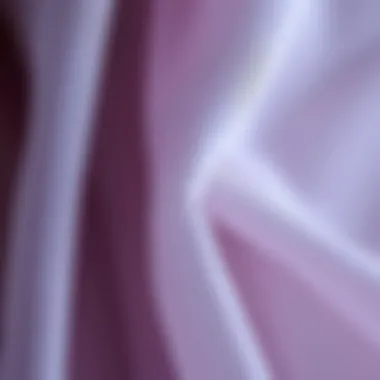

"The environment is where we all meet; where we all have a mutual interest; it is the only thing we all share." – Lady Bird Johnson
Sustainable Practices in Chiffon Production
The fashion industry is shifting towards more sustainable practices, and chiffon production is no exception. Many manufacturers are exploring methods to reduce their environmental impact.
- Eco-friendly Materials: Brands are beginning to utilize organic fibers that require fewer pesticides and fertilizers, ultimately promoting biodiversity and soil health.
- Water-Saving Technologies: Innovations such as closed-loop water systems help recycle water used during production, dramatically reducing consumption and waste.
- Natural Dyes: A growing trend within the industry is the use of plant-based dyes, which can be both beautiful and less harmful to the environment. Switching from synthetic to natural dyes marks a pivotal change in the way consumers and brands view color and sustainability.
- Recycling and Upcycling: Some designers have embraced recycling fabric waste, often converting remnants into new, unique pieces. This not only reduces waste but also encourages creativity within the industry.
In essence, sustainable practices in chiffon production aim to diminish the detrimental effects of fabric creation on the environment while providing quality options for consumers. As awareness grows, the push for eco-friendly hijabs, including those made from opaque chiffon, becomes stronger. This illustrates that mindful fashion choices can indeed coexist with style and elegance.
Consumer Education and Awareness
Consumer education and awareness play a pivotal role in enhancing the overall experience of purchasing and wearing opaque chiffon hijabs. Understanding the nuances of this specialty fabric can lead to more satisfying choices for consumers, ensuring they not only align fashion with personal beliefs but also meet practical requirements for maintenance and durability.
Understanding Fabric Care Labels
Fabric care labels are often overlooked but are crucial in extending the lifespan of chiffon hijabs. These labels offer essential information on how to properly wash, dry, and iron the material, ultimately preserving its quality and appearance. For instance, a generic label might simply indicate "machine washable," but reading further may reveal that it should be washed in cold water and tumble dried on low heat to avoid fading or damage.
Key points to understand include:
- Symbols and Terminology: Familiarity with washing symbols and terms can prevent unintentional damage. For example, a hand wash symbol indicates that the fabric is delicate and requires gentle handling.
- Fabric Composition: Knowing the exact material can influence care. Opaque chiffon’s synthetic blend may be less prone to wrinkling compared to cotton blends, requiring different washing techniques.
- Color Considerations: Pay attention to labels advising on separating colors. Mixing garments of different colors could lead to discoloration, especially in lighter fabrics.
Informed Buying Decisions
Making informed buying decisions is more than picking a stylish hijab; it’s about knowing what to look for, considering the implications on wearability and ethical practices. Shoppers should challenge themselves to ask critical questions before making a purchase.
Important aspects to consider include:
- Source and Ethos of Brands: Investigating where and how the hijab is made can reveal much about ethical sourcing. Brands that highlight sustainable or local practices can often be more trustworthy.
- Quality vs. Price: Often, cheaper options might lure buyers in, but a lower price point can signify lower quality. Examining the fabric’s feel, the stitching's integrity, and the overall craftsmanship can reveal more substantial insights about longevity, worth the potential extra dollars spent.
- Return and Exchange Policies: It’s wise for consumers to be aware of store policies regarding returns and exchanges. This transparency can enhance buyer confidence, knowing they won’t be stuck with a poor fit or quality.
By being educated and conscious consumers, shoppers can make choices that not only favor their unique styles but also respect the broader values tied to fashion and sustainability. This empowerment through knowledge fosters a deeper connection to their choices and the cultural significance behind wearing a hijab.
Diversity of Hijab Styles
Understanding the diversity of hijab styles is essential when exploring the world of opaque chiffon hijabs. This diversity not only reflects varying cultural backgrounds but also highlights an array of stylistic choices that cater to different personal expressions. Each style tells a story of identity, faith, and fashion, creating a tapestry of colors, textures, and designs that enrich the landscape of contemporary apparel. The significance of this topic lies in its ability to showcase how hijabs can serve as more than just a garment, but as symbols of empowerment and individuality.
Diversity in hijab styles offers several benefits and considerations:
- Cultural Identity: Each hijab style carries its own significance within different cultures, with variations seen in countries such as Turkey, Egypt, Indonesia, and Saudi Arabia. These styles provide a sense of belonging and representation within the community.
- Fashion Statements: With global influences and innovative designs, hijabs have transitioned from traditional attire to dynamic fashion statements. This adaptability makes them appealing to a broad audience.
- Personal Expression: Wearing a hijab allows individuals to express their unique personalities. The choice of colors, patterns, and ways of styling can convey moods and preferences.
"A hijab is not just a piece of cloth; it's an identity, a fashion statement, and a cultural representation intertwined in daily life."
By acknowledging the diversity of hijab styles, stylists, designers, and marketers can better understand the nuances that drive consumer preferences. This understanding will not only enhance the design process but also enable brands to resonate on a deeper level with their customers.
Cultural Variations in Hijab Styles
Cultural variations in hijab styles are numerous and each one is unique in its own right. For example, the Niqab, worn primarily in Gulf countries, offers a more concealing option with only the eyes visible, while the Shayla, common in the Arabian Peninsula, is a long, rectangular scarf that wraps around the shoulders.
Across the Mediterranean, the Hijab itself is styled differently, often complemented by sophisticated prints and paired with modern outfits. In South Asia, one can observe the varying styles such as the Dupatta, which drapes elegantly over the shoulder, enhancing traditional attire. These styles reflect local customs, religious practices, and fashion trends, showing that the hijab enters varied spaces while maintaining its core identity.
Importantly, cultural variations also extend to the materials and methods of fabric production, including opaque chiffon, which is particularly favored for its airy texture yet robust coverage, allowing women to feel comfortable and stylish while adhering to cultural norms.
Innovative Designs in Modern Fashion
In today's fashion industry, innovation drives the portrayal of hijabs. Designers are embracing contemporary aesthetics while reimagining traditional styles to keep up with evolving trends. This fusion results in eye-catching designs that cater to youthful consumers and those who wish for a blend of tradition and modernity in their wardrobe.
Various techniques are now employed to create stunning hijabs, such as:
- Prints and Patterns: Bringing a lively twist to opaque chiffon, designers utilize digital printing, which allows for myriad patterns, from abstract motifs to florals.
- Layering Effects: Adding depth and texture, many hijabs feature layers that provide both sophistication and uniqueness in styling.
- Accessorizing: Numeric trends are integrating accessories like brooches, pins, and belts with hijabs, which adds an exciting layer to the overall appearance.
As the face of modish hijab wearers evolves, fashion showcases not merely style but a means to challenge stereotypes while celebrating culture. The blend of innovation and diverse cultural influences continues to shape the hijab narrative, marking the fabric's journey from modest clothing to a bold statement of self-identity in global fashion.
The Role of Hijabs in Personal Identity
The significance of hijabs extends beyond mere fabric draping. They represent a blend of tradition, faith, and personal identity for many women around the world. In particular, opaque chiffon hijabs serve as a versatile tool for self-expression while adhering to cultural or religious beliefs. This section delves into two key dimensions: the expression of personal beliefs through hijabs and their influence on fashion choices.
Expression of Personal Beliefs
Hijabs often symbolize adherence to cultural and religious convictions. For many Muslim women, wearing a hijab is an act of faith, showcasing their commitment to Islamic teachings. Each individual might interpret this act differently; some see it as a way to demonstrate piety and modesty, while others embrace it as a tool for empowerment.
The choice to wear an opaque chiffon hijab can also present an opportunity for personal expression. Within the realm of an Islamic context, women can select styles and colors that represent their personality, mood, or even seasonal changes. This blend of predictability in religious practice and variability in personal expression makes the hijab a very profound aspect of identity.
"A hijab can be a crown for a woman; it empowers her by defining her identity amidst societal expectations."
Women around the world have also adapted their hijab styles based on cultural nuances. For instance, in some cultures, bold patterns or combinations signify celebration, while simpler designs tend to be preferred for everyday wear. This adaptability can reflect personal belief systems, allowing individuals to showcase their uniqueness while adhering to communal values.
Influence on Fashion Choices
The impact of wearing a hijab, particularly an opaque chiffon one, permeates various aspects of fashion. As fashion evolves, the hijab has transitioned from being viewed as a mere head covering to a significant fashion statement. Designers are now increasingly incorporating hijabs into their collections, celebrating their aesthetics and cultural importance.
- Fashion Trends: The market has seen a surge in hijab-friendly brands that cater to a stylish clientele. Women are no longer limited to traditional styles; they now have access to a diverse range of fashionable options that suit modern tastes while maintaining a level of modesty.
- Personal Style: Wearing an opaque chiffon hijab does not mean compromising personal style. Women can experiment through layering it with various outfits, mixing textures, and colors, thus influencing their overall appearance and making strong fashion statements.
Moreover, influencers and prominent figures in various industries are challenging stereotypes, proving that hijabs can be fashionable while retaining their religious significance. This increased visibility allows women with hijabs to engage with broader fashion communities, impacting their choices and those around them.
Global Perspectives on Hijab Fashion
The exploration of hijab fashion within a global context unveils diverse interpretations, styles, and cultural ramifications. Understanding these different perspectives is essential for stylists, designers, and marketers who seek to appreciate the nuances that shape the hijab’s significance in various societies. It reveals how fashion transcends mere aesthetics, reflecting deeper values, beliefs, and social narratives.
One key element in this discussion is the intersectionality of culture and fashion. Hijabs are not just pieces of cloth; they carry layers of meaning rooted in identity, tradition, and personal expression. As styles evolve globally, understanding local customs and cultural underpinnings becomes paramount.
Western vs. Eastern Fashion Trends
The distinction between Western and Eastern fashion trends significantly influences how hijabs are perceived and styled. In many Eastern cultures, hijabs embody tradition and religious obeisance, often worn in a straightforward manner that respects cultural norms. For instance, in countries like Saudi Arabia and Iran, hijabs are integral to daily life, blending seamlessly into everyday attire.
In contrast, Western interpretations often project a modern image, celebrating individuality and innovative design. Influencers in the West have adopted hijabs in vibrant colors and materials, drawing attention to their versatility and fashion potential. The blending of styles opens the door to unique combinations—allowing for the hijab to become not just a cultural symbol but also a fashion statement.
- Cultural Fusion: Cross-pollination between these distinct styles can create fresh looks. The mingling of traditional wraps with contemporary textiles not only broadens the appeal but also sparks dialogue about cultural appreciation versus appropriation.
- Fashion Statements: Designers like Diane von Fürstenberg and H&M have prominently featured hijabs in their collections, creating a conversation around inclusion, representation, and diversity.
With the rise of social media, platforms like Instagram and Pinterest have emerged as avenues for showcasing these varied styles, encouraging discussions about the purpose and meaning behind hijabs.
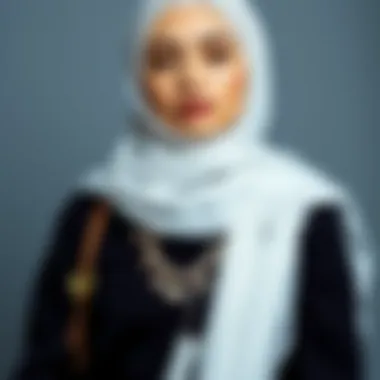

Cross-Cultural Influences in Design
Cross-cultural influences play a crucial role in shaping the evolution of hijab fashion. Designers from different backgrounds often draw inspiration from global trends, fabrics, and styles, resulting in innovative creations that transcend geographical boundaries.
For instance, the integration of African prints into hijab designs reflects a burgeoning appreciation for global diversity. Similarly, Japanese textiles have found their way into contemporary hijab fashion, promoting a fusion that respects distinct cultural origins while celebrating originality.
"Fashion is the language of the unmapped territories where cultures collide, and the hijab stands at this powerful intersection."
To illustrate this:
- Textile Innovation: The mix of lightweight chiffon with intricate embroidery from Middle Eastern traditions showcases a blend that respects classic form while courting modernity.
- Color Trends: Vibrant palettes inspired by South Asian festivals now flourish in hijab collections, appealing to a broader audience that appreciates visual storytelling through fabric.
As fashion houses continue to explore diverse inspirations, a deeper understanding of cultural context fosters respectful innovation in hijab design. This cooperative spirit not only enriches the product offerings but also paves the way for mutual respect and appreciation across cultures.
In summary, a comprehensive perspective on hijab fashion requires acknowledgment of both regional differences and the influences that arise when cultures intersect. By celebrating this complex tapestry, fashion professionals can contribute to a narrative that respects tradition while embracing contemporary styles.
The Psychological Impact of Wearing a Hijab
The decision to wear a hijab can carry significant weight, influencing various aspects of an individual's life. This piece addresses the psychological repercussions of wearing a hijab, delving into the nuanced interplay between identity, self-perception, and societal perceptions. It helps both wearers and observers gain insight into the complexities of this commonly seen garment.
Identity and Self-Perception
For many individuals, a hijab does more than just serve as a style choice; it plays a crucial role in expressing identity. Wearing a hijab often becomes a significant form of self-expression, allowing people to convey their religious beliefs, cultural backgrounds, and personal ideals. This expression might foster a sense of authenticity. Many wearers report feeling empowered by the ability to visually signify their identity.
Moreover, the hijab can be seen as a personal shield, creating a barrier against societal expectations regarding appearance. In a world that frequently values superficial attributes, the hijab can alter one's narrative, shifting the focus away from physical features and towards the wearer's intellect and character.
Conversely, the hijab can also contribute to self-doubt or conflicts regarding societal acceptance. Some may wrestle with anxiety about how they are perceived by others, particularly in unfamiliar environments. The pull between tradition and modernity can lead to internal conflict, making the journey complex. Despite the challenges, the overarching relationship between identity and the hijab tends to yield a stronger sense of self for many.
Social Interactions and Perceptions
Navigating social landscapes while wearing a hijab can be a mixed bag. Wearing a hijab can influence how wearers interact with others, shaping first impressions and ongoing assessments. On one hand, many people express that the hijab invites curiosity, leading to conversations that may foster cross-cultural understanding. These interactions create avenues for education, enabling wearers to share their beliefs and values directly with peers.
However, some encounters are less flattering. Unfortunately, biases persist, resulting in negative stereotypes or assumptions about the wearers. This can lead to instances of discrimination or microaggressions that affect a person's mental well-being. The onus often falls on the wearers to counteract these narratives, which can be an exhausting endeavor. Moreover, these social dynamics can compel some individuals to modify their behavior in social settings to confront or deflect misunderstandings.
"The hijab is not merely fabric; it embodies profound beliefs and social dynamics, shaping both identity and community belonging."
Community and Fashion Networks
In the world of fashion, especially within the realm of hijab styles, community and networks play a vital role. These connections extend beyond mere aesthetics; they create a support system that empowers both individuals and designers. For opaque chiffon hijabs, which are known for their delicate draping and versatility, engaging with a community provides insights that can refine personal styles and foster innovation in design.
Communities that share a passion for fashion, particularly hijabs, serve to uplift and inspire. Whether through social media platforms like Instagram or dedicated forums on sites such as Reddit, individuals can exchange tips, seek advice, and showcase their styles. This sense of community not only bolsters confidence but also fosters a supportive atmosphere where everyone can thrive. There is a certain camaraderie in discussing the latest trends, fabric choices, and styling techniques which resonates deeply among enthusiasts.
Support Networks in Fashion Communities
Support networks are crucial in ensuring that designers and wearers feel encouraged and understood. These networks often consist of local meet-ups, online groups, and workshops dedicated to hijab fashion. Members share experiences, promoting collaboration and helping one another navigate challenges common in the fashion industry.
For example, a local group might organize a styling event where participants can learn new wrapping techniques or discover ways to style their opaque chiffon hijabs for different occasions. These gatherings not only elevate skills but also build lasting friendships.
- Peer Support: Members can rely on one another for emotional and practical support, addressing issues such as cultural representation and personal identity through fashion choices.
- Resource Sharing: Online communities provide access to an array of resources including tutorials, design inspirations, and fabric sourcing advice.
- Mentorship: Seasoned designers often guide newcomers, helping them to develop their unique styles while encouraging experimentation with opaque chiffon.
Collaborative Design Initiatives
To further enrich community ties, many fashion networks engage in collaborative design initiatives. These projects allow various artists and designers to come together, pooling their creativity to produce unique items that reflect their collective vision. Collaborations often lead to innovative approaches in the styling and application of opaque chiffon, introducing fresh ideas that can be seamlessly integrated into modern fashion.
One notable initiative might involve a group of emerging designers tasked with creating a limited-edition collection featuring opaque chiffon hijabs. This effort not only showcases their individual talents but also highlights various cultural aesthetics, effectively bridging gaps between tradition and contemporary trends.
Such collaborations can result in:
- Enhanced Visibility: Bringing attention to less-known designers through collective branding efforts.
- Diverse Perspectives: Different backgrounds contribute to unique designs, enriching the fashion landscape.
- Synergy in Craftsmanship: Working side by side often leads to learning new techniques and material uses, further elevating the overall quality of the garments.
Future Trends in Hijab Fashion
As the world of fashion continually evolves, so too do the trends surrounding hijabs, with opaque chiffon hijabs holding a notable place in these shifting currents. The significance of focusing on future trends cannot be overstated; these styles represent not just aesthetic shifts but also cultural narratives and technological innovations. The blend of fashion with cultural identity and individual style places the hijab at the forefront of both personal expression and societal dialogue.
In this section, we will examine two main aspects driving future trends in hijab fashion: advancements in fabric technology and the changing preferences in designs. Understanding these elements helps not only stylists, designers, and marketers forecast fashion directions but also allows consumers to navigate the expanding market with greater awareness.
Technological Advancements in Fabric Production
Technological developments have revolutionized the textile industry, impacting how fabrics are produced and utilized in fashion. For opaque chiffon hijabs, these advancements mean better quality, lightweight materials that offer comfort without compromising on style. Materials are now being engineered to be more breathable, allowing for ease during various weather conditions while retaining the characteristic elegance of chiffon.
Key innovations include:
- Microfiber Technologies: Improved purely synthetic fibers that enhance durability and softness, offering a luxurious feel with a lightweight experience.
- Moisture-Wicking Fabrics: Innovations in fabric allow sweat to evaporate quickly, making wearing a hijab comfortable in diverse climates.
- Eco-Friendly Practices: As sustainability gains momentum, many manufacturers are looking toward eco-conscious methods of production, which brings about biodegradable fabrics or those made from recycled materials.
Additional benefits of these advancements include greater accessibility of diverse colors and patterns, which enables personalization according to individual taste. The blend of technology and tradition contributes to expanding the styles available in the hijab market, presenting opportunities for both wearers and designers to experiment and express creativity.
Evolving Style Preferences
The styles worn by hijab enthusiasts are consistently evolving, influenced by a kaleidoscope of factors such as cultural exchange, social media trends, and individual creativity. As these influences merge, a significant transformation is taking place in how hijabs, particularly opaque chiffon, are styled and perceived.
Staying abreast of these evolving preferences is essential for maximizing market engagement. Noteworthy trends include:
- Minimalist Aesthetics: A growing inclination towards simplicity, characterized by solid colors and sleek draping that accentuates the natural beauty of the fabric. This approach often highlights the wearer's face and personal features without overwhelming them with excessive ornamentation.
- Mix and Match Techniques: Wearers are now more inclined to layer their hijabs with various fabric types, not limited to chiffon alone. This practice creates a unique look each time, allowing for personal expression while maintaining cultural integrity.
- Cultural Fusion: The modern hijab emergence sees a blend of traditional and contemporary styles, where regional motifs and designs merge with global fashion trends. This fusion creates a rich tapestry of styles, allowing individuals to wear their identities proudly while engaging in a global dialogue about fashion.
In summary, the future of hijab fashion, specifically opaque chiffon hijabs, lies in the intersection of advanced material technologies and shifting style preferences. Understanding these trends helps not just in design and styling but also in influencing purchasing decisions in a diverse and multicultural marketplace.
Epilogue: Summary of Key Insights
In reflecting on the attributes of opaque chiffon hijabs, it’s crucial to underline their cultural, aesthetic, and practical dimensions. These hijabs are not merely pieces of fabric but rather significant garments that blend tradition and modernity.
Cultural Essence
The opaque chiffon hijab represents a rich historical tapestry, deeply rooted in various cultures around the globe. Wearing a hijab can signify a myriad of beliefs, expressions of identity, and adherence to tradition. The significance varies by region and personal choice, encouraging a deeper understanding among stylists and marketers. This necessity for cultural sensitivity can't be overstated; recognizing the layers of meaning is essential for any designer or brand targeting hijab fashion.
Styling and Versatility
Another compelling takeaway is the versatility of styling options available with opaque chiffon. From specific layering techniques to color coordination for different occasions, these hijabs can be tailored to suit both casual outings and formal gatherings. As the preferences evolve, stylists should be attuned to creating designs that cater to both traditional contexts and contemporary fashion statements, allowing space for innovation.
Sustainability Matters
Additonally, discussions around sustainable practices in fabric production are becoming more pertinent. As designers and brands delve into the market, considerations of environmentally friendly materials and production methods will surely influence consumer choices. A shift towards sustainability is hardly a fleeting trend; it’s shaping the future of fashion, including hijab styles.
Consumer Education
Furthermore, fostering consumer education is key. With various fabric labels and care instructions, demystifying these elements can empower buyers to make informed decisions about their purchases. The better consumers understand their options, the more they appreciate the nuances, including the durability and care that come with opaque chiffon.
“A well-informed consumer is the best advocate for a brand.”
To summarize, opaque chiffon hijabs offer a rich interplay of culture, style, sustainability, and consumer awareness. As the world of hijab fashion continues to evolve, it remains essential for designers, stylists, and marketers to remain engaged in these discussions. By embracing the significance and intricacies of opaque chiffon, the fashion industry can facilitate a deeper connection with its audience while paving the way for innovative designs that honor tradition and embrace change.
For further reading and insights, please refer to the following resources:
- Wikipedia on Hijabs
- Britannica on Islamic Clothing
- Reddit discussions on Hijab Fashion
- Fashion and Sustainability Trends






